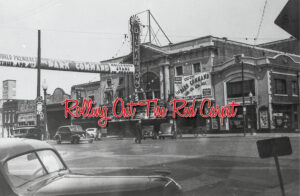Let the Hills and Vales Resound
The Kansas State Musical Jubilee
| 2019 Q1 | story by Patricia A. Michaelis, Ph.D. Historical Research & Archival Consulting | photos from the Kansas State Historical Society, kansasmemory.org

Music filled the air at Bismarck Grove on August 18 and 19, 1881. A massed chorus and soloists entertained audiences during the Kansas State Musical Jubilee. The event was the brain child of Charles E. Leslie, a musician, composer, music publisher, and entrepreneur, from Chicago, Illinois. Professor Leslie recruited choral directors from across the state to help train the musicians that would perform at the tabernacle in Bismarck Grove. Today, Bismarck Grove is located on Lyons Street between East 1550 Road and East 1600 Road. From East 1550 Road, take a right on Lyons Street. It curves north and then back to the east. Bismarck Grove is north of Lyons Street as it curves back east.
Leslie organized the first local chorus in Salina in May 1881. More than 200 people participated. He described his intentions as follows:
- hold a musical convention for one week in each town; three sessions a day. The morning lesson for beginners—teaching the theory and practice of note-reading; the afternoon lesson—a step in advance of the morning study; the evening session—voice culture, musical elocution and the practice and rendition of the choruses to be used at the four grand concerts of the jubilee.
Leslie planned to organize six groups each week, and he chose more than 20 directors/conductors to continue to lead the groups in practice until the August gathering. He claimed to have organized groups in 73 communities, with the choruses totaling more than 10,000 participants. Lawrence had organized the largest chorus, with 630 voices. Leslie hoped the choruses in the various Kansas towns would become permanent organizations to continue to practice and perform. Many of the performers gathered on the evening of Aug. 17, 1881, for a rehearsal, the first time the groups trained across the state had a chance to sing together. Each day of the jubilee featured an afternoon and an evening concert, with approximately 20 numbers per concert. The chorus had approximately 6000 members with 1800 sopranos, 1600 altos, 1200 tenors and 1400 basses. In addition to the songs presented by the massed choir, several professional but not well-known musicians employed by Leslie performed solos. Each concert was divided into two parts, and at the end of each part, the audience joined the chorus in a well-known song like “America” or “All Hail the Power of Jesus’ Name.” Two Chickering grand pianos provided accompaniment to the singers.
A description of the events of Aug. 19 was provided by the newspaper. A light rain had settled the dust, and the crowd on the second day was believed to be twice the size of the first. The Times contained the following description of the activities at Bismarck Grove:
- Bismarck to-day presents much the appearance of fair week. The immense throng of people surges to and fro about the grove; the bands play, bells ring, the peanut and lemonade peddlers push themselves about, loudly crying their wars, and mixed with the strains of melody from the concerts rises the shrill whistle of the “merry go round” and the shout of the lung-tester man. All day the people continue to arrive at the Grove, not only on trains, but in buggies and wagons and on foot, farmers for miles around coming in to hear the great jubilee.
One of the bands playing for the crowds was the 10-piece Wamego Silver Cornet Band.
In addition to being a fairgrounds and a place for temperance meetings, Bismarck Grove was also a campground. The Ellis County Star, published in Hays, Kansas, described the scene in its Aug. 20, 1881, issue.
- Up from the plains and valleys, out from the cities and towns they come, until the Grove was one living mass of humanity, all was bustle and confusion, and at first the accommodations were insufficient, baggage of all kinds was thrown about indiscriminately, tents were hastily improvised and erected, and soon order was brought out of chaos, for you must know that Kansas never does things by halves, and Bismarck is the “hub” just now, around which all other things revolve. A small town was soon built. There were the myriad lights of booths and lunch stands, the shooting galleries, swings, prize-package man and other nuisances, all presenting a scene not easily described.
These descriptions help us understand how so many people could be accommodated since Lawrence had a limited number of motels. We also think of camping for recreation as a recent phenomenon, but it did exist in the 19th century. In addition to horse-drawn vehicles, regular and special excursion trains brought people to Bismarck Grove, which had its own tracks near the regular line. The largest structure at the Grove was the Tabernacle. For the jubilee, the seats were removed, and the musicians stood on the remaining tiers for their performances. The audiences listened to the chorus from outside the building.
The Hays newspaper also contained descriptions of the performances of the soloists, as well as documented the attire of the female singers. For example, it noted that Emma Mabella had a “rich contralto voice—one of those mellow voices that have both power, pathos and sweetness.” The account indicated she was popular with the audience and was encouraged by them to provide numerous encores. She was described as being “robed in pink silk, court train, real lace flounces, pale crush roses in her hair and corsage is quite fleshy, had black hair, dark blue eyes, and is very pleasing in her manners.”
The performers included “Mademoiselle” Zerline Mantey, a violinist. She was said to have played with skillful execution and was called upon to do a number of encores. The description of her appearance was quite vivid: “She is large but finely formed; had black eyes and hair—a German. She wore on one occasion, a cream silk princess dress, with cardinal polka dots, draped with heavy cord tassels, short white lace sleeves, red crush roses; at another time black Spanish lace, with water lilies.”
The descriptions of the male soloists concentrated on their vocal skills. George Broderick was a baritone whose voice had “profound depths, and wonderful power. It was reported that he was engaged to Miss Mabella (they did marry at a later date). Charles Knorr, a tenor, was able to reach to “the height and depth of musical excellence.”
As is possible in most events, technology caused some problems. Electric lights were used in the evenings, but they were not reliable, Emergency lights were provided. When they were working, the lights contributed to the atmosphere of the Jubilee as follows: “The scene was beautiful beyond description, the vast ocean of faces, the beautiful costumes of varied hues, the lamps sending their glittering shafts of light like arrows, piercing the darkest nook, and throwing their opal phosphorescent rays over all, making the trees look unearthly and the people like disembodied spirits.” This reporter, at least, was enchanted by the effect.
While words can describe what happened at the Kansas State Musical Jubilee, it is impossible to reproduce the music made by thousands of musicians and heard by more than 10 thousand audience members. The success of this jubilee indicated there was a great interest in the art of music-making, and listeners at Bismarck Grove heard compositions ranging from classical music to more popular tunes. C. E. Leslie accomplished what he set out to do—forming a massive chorus. He gave his wife, Allie, great credit for making it all possible. The Kansas State Musical Jubilee was believed to be the largest event in Kansas history at the time.



